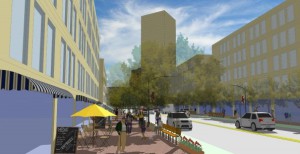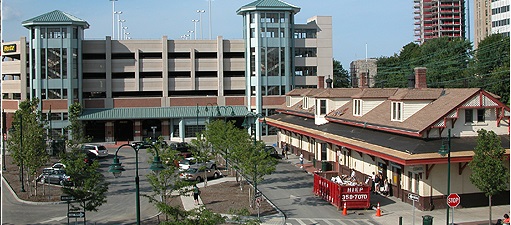The TOD Study establishes the needed sustainable framework for the future development of the City of New Rochelle.
-Luiz Aragon, Commissioner of Development, New Rochelle
Empire State Future has long supported transit-oriented development (TOD) as a way to revitalize urban cores, improve housing options and enhance existing transit services. We recognize the opportunity for TOD to solve land use inefficiencies, while simultaneously promoting investment in city and village centers, where high transit access and dependency already exists.
One city that is taking advantage of what TOD has to offer is New Rochelle. Located in the lower Hudson Valley, New Rochelle is a thirty-eight minute Metro North ride into Grand Central Station. This month, the city published its TOD Smart Growth Study developed to strategize new residential and commercial development opportunities around the New Rochelle Transit Center. This is a great opportunity for the city to act as a model for other commuter towns to develop sustainable and diverse communities that people want to live in, not just commute out of.

A rendering from the Study shows new residential buildings with ground-floor retail space along North Avenue, street tree planting and bicycle lanes.
Although it has been over two years since the request for proposals for New Rochelle’s TOD study, the unveiling of the report is just the beginning of a long road ahead for the city if it wants to be successful in its efforts. As far as goals and priorities included within the report, New Rochelle is on the right track. They are dedicated to offering a range of housing options, so to include all income levels. The city recognizes that reducing parking requirements is key to both right-sizing development and promoting alternative travel options. They have included streetscape improvements, focusing on bicyclist and pedestrian needs. New Rochelle realizes that by making these key improvements they can enhance their ability to market themselves as a dynamic urban destination.
New Rochelle, like many other communities that take on large revitalization projects, has some barriers to overcome. Zoning changes will be important in order for the TOD area to have the dense, mixed-use development it needs to succeed. This can be a daunting task, both to accomplish and to get the community on board. The Tri-State Transportation Campaign (TSTC) recognizes public participation as an important tool for communities to promote TOD. TSTC recommends including the public as much as possible throughout the process, making them more likely to agree to major changes and allowing the process to move forward smoothly.
Community input is one of the most important factors to the success of TOD. TOD should reflect the mobility, housing, retail, and job needs of the community. The best way to craft a successful TOD proposal is to engage the public and solicit feedback on their needs at the onset, before municipalities come up with a plan.
-Veronica Vanterpool, TSTC
Another organization offering tools to communities looking to implement Smart Growth Development is the Environmental Protection Agency (EPA). EPA recognizes the importance of good codes as the framework for smart planning and development. They offer examples of codes that “guide everything from permissible land uses, to building densities, locations, and setbacks, to street widths and parking requirements.” By learning from past TOD success stories, New Rochelle can avoid making costly mistakes.
A physical barrier to the project is the New England Thruway, which runs through the center of the city. It encourages car dependency in the area, inhibits development while creating an unpleasant experience for bicyclists and pedestrians. The study includes pedestrian access to the train station via a pedestrian bridge over the thruway. It is important that this connection is effective as more than just access to parking garages, so to encourage walking by linking the neighborhood and medical facility north of the Thruway to the Transit Center and downtown.
![The Bee-Line Bus System serves New Rochelle residents, as well as other parts of Westchester County (Photo courtesy of The Rail & Bus [Transport Net])](https://empirestatefuture.org/wp-content/uploads/beeline-newrochelle-300x168.jpg)
The Bee-Line Bus System serves New Rochelle residents, as well as other parts of Westchester County (Photo courtesy of The Rail & Bus [Transport Net])
While making the TOD Zone more attractive to live in, the city should continue to accommodate the range of income levels currently residing in the area. While the median household income for New Rochelle is about $66,000 according to the 2010 Census, the majority of those households on the higher end are outside of the city center. If lower income residents are pushed out of the TOD area, where do they go? Not only can they not afford to live in the wealthy suburbs of Westchester County, but also they rely on the proximity to bus routes that the city center provides. Community stakeholders that were interviewed for the study vocalized the need for housing that is affordable to all, suggesting the creation of a Transit-Oriented Affordable Housing (TOAH) Fund.
In EPA’s report Encouraging Transit Oriented Development, it cites the use of affordable housing trust funds like TOAH and land bank funds as a way to preserve the existing housing and build new affordable housing. As the demand for housing in these locations goes up, so will the price of real estate. Therefore, by making these necessary investments New Rochelle can ensure that lower-income residents will not be left out.
With these things in mind, the New Rochelle Smart Growth TOD Study brings the opportunity to jump start similar projects in New York State that can have long-term effects on how New Yorkers live, work, shop and travel. It is important that moving forward, the City of New Rochelle continues to promote collaboration among the different stakeholders who will help drive this process forward. Public agencies should work with the private sector to ensure investment done the right way. Also, the community should be included throughout the development process through education and outreach efforts. This inclusion will help ensure that the purpose of the development is understood and supported by city residents.
You can view the report on the New York & Connecticut Sustainable Communities website:
Transit Oriented Development Smart Growth Study, New Rochelle, NY (January 2014)
Learn more about TOD and other efforts by reading our past blogs:
Transit-Oriented Development: vital to an interconnected system
Equitable Transit-Oriented Development (ETOD) Opportunities in New York State




